Résultats de recherche de titre
Articles 1500721 à 1500740 sur 1501610
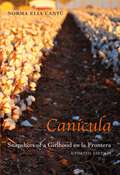
Canícula: Snapshots of a Girlhood en la Frontera. Updated Edition.
Par Norma Elia Cantú. 2015
Winner of the Premio Aztlán Literary PrizeCanícula—the dog days—a particularly intense part of the summer when most cotton is harvested…
in South Texas. In Norma Cantú&’s fictionalized memoir of Laredo in the 1940s, 1950s, and early 1960s, it also represents a time between childhood and a still-unknown adulthood. Snapshots and the author&’s re-created memories allow readers to experience the pivotal events of this world—births, deaths, injuries, fiestas, and rites of passage.In celebration of the twentieth anniversary of the original publication, this updated edition includes newly written pieces as well as never-before-published images—culled from hundreds of the author&’s family photos—adding further depth and insight into this unique contribution to Chicana literature.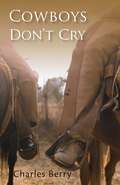
Cowboys Don't Cry
Par Charles Berry. 2011
Scout McBride was born into ranching life in the West Texas desert outside El Paso. He learned to ride a…
horse almost before he could walk, grew up communicating with animals around the harsh land, and spoke Spanish with his first friend, a boy from Mexico. It was a tough environment for one so young and as Scout follows a rugged path to becoming a man, he knows that to emulate the men he admires, he must keep one thing in mind: Cowboys don't cry.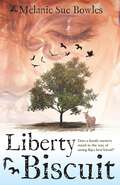
Liberty Biscuit
Par Melanie Sue Bowles. 2022
Katherine Pearl Baker—&“Kip&” for short—is the only child on her family's rural peach farm. She longs for a pet to…
ease the loneliness. Unfortunately, her father has an angry opposition to all animals—horses in particular. Why he dislikes them is a confounding mystery.Hiding in the woods on the Fourth of July, Kip encounters a bedraggled donkey with one eye and a floppy ear. Immediately smitten and compelled to protect him, she feeds him biscuits and takes him home. When it is discovered the donkey fled an abusive owner, Kip's father finally relents, reluctantly allowing him to stay.Kip is elated when her grandfather agrees to help her foster the donkey, who she names &“Liberty Biscuit,&” along with two emaciated horses removed by the local sheriff from the same home, as the cruelty case goes to court. While caring for the animals, Kip's happiness is overshadowed by a shocking discovery in a trunk in the family farm's hayloft—a faded photograph of her father as a boy that reveals secrets long kept.A court order to return the horses, and even worse, Kip's beloved Liberty Biscuit, to the owner who had starved and beaten them, throws Kip's world into turmoil. She knows she must find a way to keep them, or she will have betrayed the best friend she has ever had. But saving the animals means risking the complete unraveling of her family as she exposes the long-buried truth about a tragic accident and a hurt like she's never known before.Ages 9-13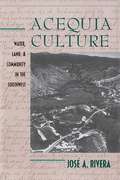
Acequia Culture: Water, Land, and Community in the Southwest
Par José A. Rivera. 1998
Conflicts between Hispanic farmers and developers made for compelling reading in The Milagro Beanfield War, the famous novel of life…
in a northern New Mexico village in which tradition triumphs over modernity. But as cities grow and industries expand, are acequias, or community irrigation ditches, a wise and efficient use of water in the arid Southwest? José Rivera presents the contemporary case for the value of acequias and the communities they nurture in the river valleys of southern Colorado and New Mexico. Recognizing that water is the lifeblood of the community, Rivera delineates an acequia culture based on a reciprocal relationship between irrigation and community. The acequia experience grows out of a conservation ethic and a tradition of sharing that should be recognized and preserved in an age of increasing competition for scarce water resources.A worthwhile contribution to the future management of water resources.--Professor Michael C. Meyer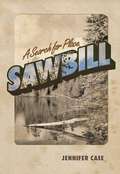
Sawbill: A Search for Place
Par Jennifer Case. 2018
In Sawbill Jennifer Case watches her family suddenly exchange their rooted existence for a series of relocations that take them…
across the United States. In response Case struggles to &“live in place&” without a geographical home, a struggle that leads her to search for grounding in the now-dismantled fishing resort her grandparents ran in northeastern Minnesota. By chronicling her migratory adulthood alongside the similarly unpredictable history of Sawbill Lodge, this memoir offers a resonant meditation on home, family, environment, and the human desire for place in the inherently mobile twenty-first century.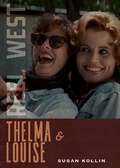
Thelma & Louise (Reel West Series)
Par Susan Kollin. 2023
Thelma & Louise, the 1991 film directed by Ridley Scott and starring Susan Sarandon and Geena Davis, has been described…
as a road movie, a buddy movie, a feminist parable, and only incidentally as a Western. An Oscar winner for first-time screenwriter Callie Khouri, Thelma & Louise catalyzed a national conversation about women, violence, and self-determination in a Hollywood still shrugging off the West of John Wayne and in an America that still viewed women as accessories to the national mythology.In this latest volume in the Reel West Series series, Susan Kollin recreates this watershed moment for women&’s movies in general and women&’s Westerns in particular.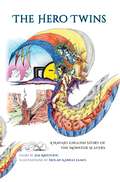
The Hero Twins: A Navajo-English Story of the Monster Slayers
Par Jim Kristofic. 2015
The Hero Twins tells the story of two brothers born to Changing Woman and trained by the Holy People to…
save their people from the naayéé&’, a race of monsters. But the naayéé&’ can&’t be beaten alone. Family and friends and wise mentors must lead any warrior down the good path toward victory. Colorful illustrations show the action as the twins seek out their father to receive the weapons they need to face the greatest monster of them all: Yé&’iitsoh.Told in Navajo, the Diné language, and English, this story exists in many versions, and all demonstrate the importance of thinking, patience, persistence, bravery, and reverence. These teachings still help the Diné—and everyone—find the harmony of a balanced and braver life.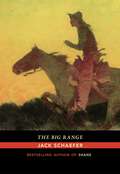
The Big Range
Par Jack Schaefer. 1953
Schaefer shares the individual stories of seven people—rancher, sheepherder, homesteader, town settler, soldier, miner, and cowboy—in this collection. He tells…
the tales as they can only be told: in the open spaces of the Old West. In these memorable narratives Schaefer depicts the unique conflicts of settler life and captures the spirit of the resolute, willful, determined, and broken characters found on the Western frontier.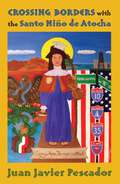
Crossing Borders with the Santo Niño de Atocha
Par Juan Javier Pescador. 2009
Crossing Borders with the Santo Niño de Atocha journeys through the genesis, development, and various metamorphoses in the veneration of…
the Holy Child of Atocha, from its origins in Zacatecas in the late colonial period through its different transformations over the centuries, across lands and borders, and to the ultimate rising as a defining religious devotion for the Mexican/Chicano experience in the United States.It is a vivid account of the historical origins of the Santo Niño de Atocha and His transformations Everywhere He ever walked, first in the nineteenth century, along the Camino de Tierra Adentro between Zacatecas and New Mexico, to His consolidation as a saint for the Borderlands, and finally, to His contemporary metamorphosis as a border-crossing religious symbol for the immigrant experience and the Mexican/Chicano communities in the United States.Using a wide variety of visual and written materials from archives in Spain, Mexico, and the United States, along with oral history interviews, participant observation, photography, popular art, thanksgiving paintings, and private letters addressed to the Holy Child, Juan Javier Pescador presents the fascinating and intimate history of this religious symbol native to the Borderlands, while dispelling some myths and inaccurate references. Including narrative vignettes with his own personal experiences and fragments of his family's interactions with the Holy Child of Atocha, Pescador presents the book as a thanksgiving testimony of the prominent position the Santo Niño de Atocha has enjoyed in the altarcitos of my family and the dear place He has carved in the hearts of my ancestors.Visit the author's website at www.pescadorarte.com to learn more and to see images of the Santo Niño de Atocha included in the book.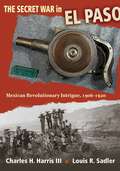
The Secret War in El Paso: Mexican Revolutionary Intrigue, 1906-1920
Par Louis R. Sadler, Charles H. Harris. 2009
Winner of the 2010 Spur Award for Best Contemporary Nonfiction from Western Writers of AmericaThe Mexican Revolution could not have…
succeeded without the use of American territory as a secret base of operations, a source of munitions, money, and volunteers, a refuge for personnel, an arena for propaganda, and a market for revolutionary loot. El Paso, the largest and most important American city on the Mexican border during this time, was the scene of many clandestine operations as American businesses and the U.S. federal government sought to maintain their influences in Mexico and protect national interest while keeping an eye on key Revolutionary figures. In addition, the city served as refuge to a cast of characters that included revolutionists, adventurers, smugglers, gunrunners, counterfeiters, propagandists, secret agents, double agents, criminals, and confidence men. Using 80,000 pages of previously classified FBI documents on the Mexican Revolution and hundreds of Mexican secret agent reports from El Paso and Ciudad Juarez in the Mexican Ministry of Foreign Relations archive, Charles Harris and Louis Sadler examine the mechanics of rebellion in a town where factional loyalty was fragile and treachery was elevated to an art form. As a case study, this slice of El Paso's, and America's, history adds new dimensions to what is known about the Mexican Revolution.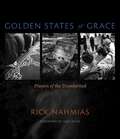
Golden States of Grace: Prayers of the Disinherited
Par Rick Nahmias. 2010
Taking California as a window into the diversity of religion in America, Golden States of Grace documents marginalized communities at…
prayer in their own faith traditions. The collection is thoroughly interfaith, introducing us to the nation's only halfway house for addicts self-identified as Jewish, a transsexual gospel choir, a Buddhist community in San Quentin, a Mormon congregation organized by the deaf for the deaf, Latina sex workers worshipping the female folk deity Santísima Muerte, and more. Depictions of conventional middle-class religion are widely visible in the media, but the American public rarely sees the sacred worlds of society's marginalized: the outcasts, the fallen, those that have been labeled "other" - ironically, those whom religion aims to serve. The poignant stories Nahmias has gathered here cross numerous boundaries and ask difficult questions few outsiders have been willing to pose.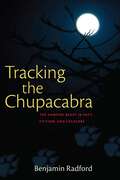
Tracking the Chupacabra: The Vampire Beast in Fact, Fiction, and Folklore
Par Benjamin Radford. 2011
Among the monsters said to roam the world&’s jungles and desolate deserts, none is more feared than the chupacabra—-the blood-sucking…
beast blamed for the mysterious deaths of thousands of animals since the 1990s. To some it is a joke; to many it is a very real threat and even a harbinger of the apocalypse. Originating in Latin America yet known worldwide, the chupacabra is a contradictory and bizarre blend of vampire and shapeshifter, changing its appearance and characteristics depending on when and where it is seen. Rooted in conspiracy theory and anti-American sentiment, the beast is said to be the result of Frankenstein-like secret U.S. government experiments in the Puerto Rican jungles.Combining five years of careful investigation (including information from eyewitness accounts, field research, and forensic analysis) with a close study of the creature&’s cultural and folkloric significance, Radford&’s book is the first to fully explore and try to solve the decades-old mystery of the chupacabra.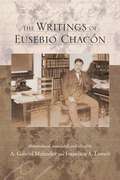
The Writings of Eusebio Chacón (Pasó Por Aquí Series on the Nuevomexicano Literary Heritage)
Par A. Gabriel Meléndez and Francisco A. Lomelí. 2012
Eusebio Chacón, born in Peñasco, New Mexico, is arguably one of the most significant and most overlooked figures in New…
Mexico's cultural heritage. He earned a law degree from Notre Dame and returned to practice law in Trinidad, Colorado. He served as a district attorney for Las Animas County, Colorado, and as a translator for the U.S. Court of Private Land Claims. In 1898, he began to write and edit for El Progreso, in which many of his articles exposed the unjust treatment of Hispanics in Colorado and New Mexico. He was also New Mexico's first novelist, and took pride in his pioneering efforts to establish a Nuevomexicano literary tradition. This collection of Chacón's writings brings together all published and written materials found, displaying his versatility with samples of his work as an accomplished orator, translator, essayist, historian, novelist, and poet.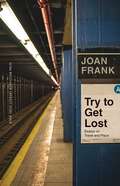
Through the author&’s travels in Europe and the United States, Try to Get Lost explores the quest for place that…
compels and defines us: the things we carry, how politics infuse geography, media&’s depictions of an idea of home, the ancient and modern reverberations of the word &“hotel,&” and the ceaseless discovery generated by encounters with self and others on familiar and foreign ground. Frank posits that in fact time itself may be our ultimate, inhabited place—the &“vastest real estate we know,&” with a &“stunningly short&” lease.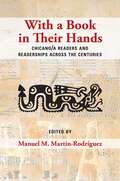
With a Book in Their Hands: Chicano/a Readers and Readerships across the Centuries
Par Manuel M. Martín-Rodríguez. 2014
First Place Winner of the 2015 International Latino Book Award for Best Latino Focused Nonfiction Book Literary history is a…
history of reading. What happens during the act of reading is the subject of the branch of literary scholarship known as reader-response theory. Does the text guide the reader? Does the reader operate independently of the text? Questions like these shape the approach of the essays in this book, edited by a scholar known for his groundbreaking work in using reader-response theory as a window into Chicana and Chicano literature. Manuel M. Martín-Rodríguez has overseen several research projects aimed at documenting Chicana and Chicano reading practices and experiences. Here he gathers diverse and passionate accounts of reading drawn from that research. For many, books served as refuges from the sorrows of a childhood marked by violence or parental abandonment. Several of the contributors here salute the roles of teachers in introducing poetry and stories into their lives.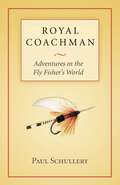
Royal Coachman: Adventures in the Fly Fisher's World
Par Paul Schullery. 2007
In Royal Coachman Paul Schullery is at once erudite emissary of the angle and consummate trout bum. And because not…
everyone can be both, we praise him as an American original.--James Prosek, author of Trout: An Illustrated History and The Complete AnglerFew have as much passion for fly-fishing as Paul Schullery, and even fewer have his endless curiosity about the history of the sport, but it is his awesome talent as a writer that makes Royal Coachman such fine and fun reading. He makes his passion, and his knowledge, so compelling that they become yours as much as his.--Gary LaFontaine, author of The Dry Fly: New AnglesThe title derives from one of the most popular and versatile flies available, and the book delivers some meticulous history on the subject of fly patterns and their creators. . . . He gets at the culture, the mechanics and the evolution of the sport in an engaging and informative way. He also undertakes the question . . . of whether or not casting a dry fly can truly be called an art with a capital 'A.' He is to be congratulated for doing so without the usual he-man bombast or Zen-master voodoo so often found in rod and gun writing.--The New York Times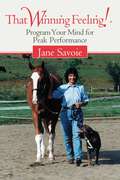
That Winning Feeling!
Par Jane Savoie. 1992
Jane Savoie presents a revolutionary approach to riding by which you can train your mind and shape your attitudes to…
achieve higher levels of skill than every imaged.The book deals with such concepts asluckworrydreams&“loser&’s limp&”commitmentcriticismfrustrationinspirationYou will learn relaxation exercises that will not only rid you of stress and tension, but will also enable you to benefit fully from the use of &“imaging&” as a working tool to achieve desired ends. And you will skillfully invoke the &“As Ifprinciple&” to think and behave &“as if&” you are already experiencing your wants and needs.The author explains how words, and word-images, play a major role in determining your actions. For example, if you say &“challenge&” instead of &“problem,&” you will positively enhance your performance.The &“training&” chapters take all the general principles and apply them to specific riding situations. The final chapters deal with &“competition,&” focusing all the tools and techniques learned earlier on actual performance scenarios.Throughout the informative and spirited text, there are scores of personal anecdotes about some of America&’s leading riders—and their affinity with the ideas and teaching of the author.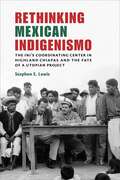
Mexico&’s National Indigenist Institute (INI) was at the vanguard of hemispheric indigenismo from 1951 through the mid-1970s, thanks to the…
innovative development projects that were first introduced at its pilot Tseltal-Tsotsil Coordinating Center in highland Chiapas. This book traces how indigenista innovation gave way to stagnation as local opposition, shifting national priorities, and waning financial support took their toll. After 1970 indigenismo may have served the populist aims of president Luis Echeverría, but Mexican anthropologists, indigenistas, and the indigenous themselves increasingly challenged INI theory and practice and rendered them obsolete.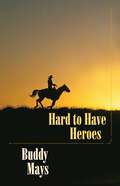
Hard to Have Heroes
Par Buddy Mays. 2012
When fourteen-year-old wannabe cowboy Noah Odell and his widowed mother leave rainy Gold Hill, Oregon, to join Noah&’s flamboyant uncle…
Bud on a ranch in New Mexico, they find themselves in the middle of nowhere with daily temperatures in excess of 100 degrees; enough rattlesnakes, buzzards, and hungry coyotes to start a zoo; a dozen scrawny steers; and a smelly outdoor toilet overrun with black widow spiders.When Bud presents Noah with a cantankerous mule named Brimstone, the adventures begin. Accompanied by his new best friends—an unlikely cowboy philosopher named Marvin Couch and a precocious tomboy prodigy named LaDonna Hawthorne—Noah and his mule encounter some of the Chihuahuan Desert&’s strangest characters. Green space monsters, eccentric Apache college professors, jackalopes, royal Spanish ghosts, and an inept gang of local bullies assure that the days are never dull, especially when the U.S. Army lawyers and MPs try to confiscate Bud&’s ranch to expand a top-secret rocket-testing facility at nearby White Sands Proving Ground.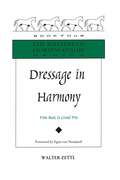
Dressage in Harmony
Par Walter Zettl. 1998
While teaching lessons and clinics across North America in the late 1990s, Walter Zettl was struck by the hunger for…
knowledge of classical training principles, which was challenged by both the vastness of the geographic range and the lack of any organized system for delivering correct information. This book was written to meet what he identified then as a need: to serve as both a complete treatise and handy reference. Clear and easy-to-understand chapters take you through each training stage, discuss problems that commonly occur, and provide competent, sensible corrections with the good of the horse in mind.